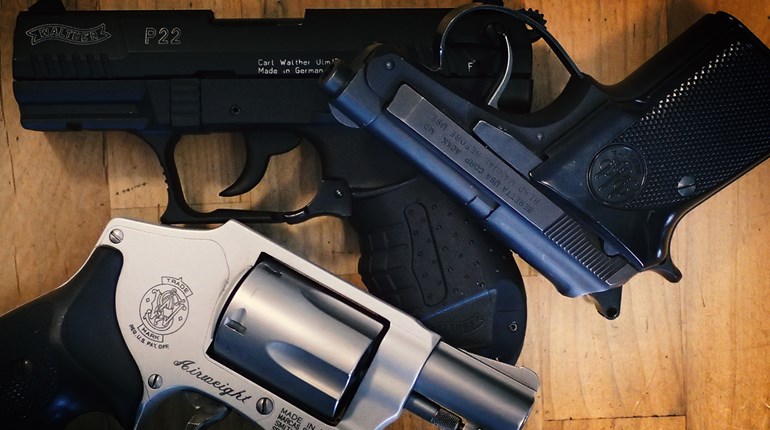
Consider the small “carry” pistol: Notoriously difficult to shoot with precision, its appeal remains thoroughly rational. A “difficult” pistol carried, after all, is far more likely to provide
a measure of security than an “easy” (but usually larger) one left home. Worse, the factors governing “carryability” vs. “shootability” are often hazy and decidedly personal.
But—and you knew there had to be one—we suggest there is a way to think about this problem as well as a corresponding technique that can reduce small-pistol inaccuracy and comfort/control issues by a surprising margin.
Trigger press is key to any accurate shot, but small pistols change the geometry of grip and relative trigger/finger position. These in turn affect sight alignment—often and inconveniently at juuuuust the moment the shot is initiated.
The key is to stop placing the “pad” of the index finger on the trigger face as we do. This is an issue particularly if your background is the 1911 or a single-
action revolver (or manually-cocked double action). Especially on a small handgun, this finger position complicates the arc of travel in a way that noticeably degrades sight alignment. It also weakens the digit by over-curling it. Grip is weakened too, as the third knuckle where the finger actually joins the hand is now off the pistol.
Instead, stick as much of the trigger finger as possible through the trigger guard. This may mean you are pressing the trigger well toward the second knuckle, but this is exactly what you’re after. By repositioning this key contact, the trigger seems easier to press due to the lack of over-curl in the digit, and through a smoother, seemingly shorter arc of travel. Of course the trigger arc isn’t actually shorter, but it does reliably feel that way due to the change in how leverage is applied. Lastly, that third knuckle is now back on the pistol, strengthening overall grip and trapping more recoil energy in the gun. A small pistol—particularly if of blowback design—may well need such firmness to reliably operate. It’s especially important if you must fire with only one hand.
Note that weak hand position must often be adjusted for the emergence of the tip of the trigger finger on the other side of the pistol—experimentation is the
answer here. Rolling the weak hand thumb off and down slightly provides enough clearance for us on most pistols, but many other solutions are possible.
Like most technique changes, a magazine or two won’t be sufficient to tell if this will help any individual shooter. Don’t make yourself miserable, but don’t give up too soon, either. The track record of this method is excellent for making the pocket gun more accurate and reliable.
Another unexpected benefit may accrue with this modification of your grip/trigger architecture: A surprising number of shooters find that the technique helps on larger pistols too. Many traditionally “difficult” (read heavy) triggers seem to run more smoothly with this technique, striker-fired ignition systems particularly. Not just accuracy, but accuracy at speed often results.
Frank Winn is the Guns & Gear editor for NRA American Warrior magazine.


































